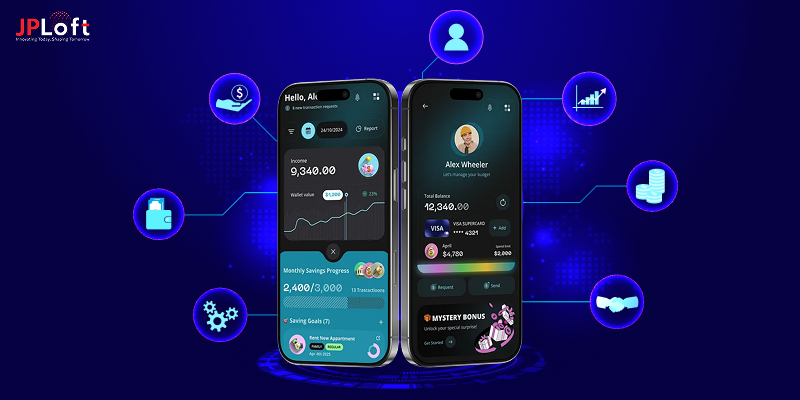Key Takeaways:
The average fintech app development cost ranges from $25,000 to $250,000, depending on app type, features, and compliance needs.
A personal finance app with basic features can cost $25,000 to, $60,000, whereas the cost to build a payment or wallet app can be $40,000 – $120,000.
The factors, such as changing regulations, data and cloud costs, API upgrades, and delayed development, result in the hidden costs to build a fintech app.
The effective ways to control the cost include starting with an MVP, opting for cloud infrastructure, planning for cross-platform development, and more.
Fintech apps can earn money through subscriptions, transaction fees, partnerships, and white-label licensing.
Partnering with an experienced firm like JPLoft ensures cost-efficient fintech app development without compromising on quality.
The fintech sector is among the sectors experiencing rapid growth globally. With multiple verticals and business opportunities, this sector has something for every entrepreneur. The global fintech market is expected to reach USD 1,126.64 billion by 2032.
Such a growth portrays a growth of approximately 16% Y-o-Y, which is quite promising for new-age entrepreneurs.
But developing a fintech platform is not easy; several factors need to be considered, from the business model to the cost to develop a mobile fintech app, monetization approach, and scalability.
The average development cost of a fintech app can range from $25,000 to $250,000 or even more, depending on several factors. If you are planning to enter the fintech space, then this blog is for you.
In this blog, we will discuss how much does it cost to build a fintech app and associated elements in detail. From the cost to app monetization models, as well as tips to reduce the overall development cost. Let’s begin.
Fintech App Market Stats
Focusing on the global fintech statistics can provide a better view of why you should invest in a fintech app and what the future of fintech apps is all about.
-
The global fintech market was valued at US$340.10 billion in 2024, with an expected value of approximately US$394.88 billion in 2025, and a projection to reach US$1,126.64 billion by 2032.
-
On the app-side: revenues of digital banking apps and neobanks worldwide hit an estimated US$39.5 billion in 2024, growing 17.9% year-on-year.
-
In 2024, mobile payments alone worldwide reached a transaction volume of about US$8.1 trillion, marking a 9.4 % annual increase.
-
Adoption gets interesting: globally, over 78% of internet users in 2025 now use at least one fintech service monthly.
-
Despite the revenue size, fintechs still only represent about 3% of traditional banking and insurance revenue globally. But, they’re growing about three times faster than incumbent banks.
-
Funding and investment trends: In H1 2025, global fintech funding hit about US$44.7 billion across 2,216 deals.
These statistics are not just numbers, but reflect the potential the fintech sector has for both the existing and the firms entering the space.
So, if you are planning to start a fintech business, it's never too late to consider how much does it cost to create a fintech app. Also, to check out the fintech app development trends and bring your vision to reality.
Why You Should Build a Fintech App?
Fintech apps are not just beneficial for the users, but they also have a set of benefits for the entrepreneurs. Focusing on these reasons can help you make your decision, validate the cost to develop a mobile fintech app, and set your budget for your next fintech app.
1. Users Prefer Convenience
More users are turning to fintech apps for their daily tasks, from paying bills and sending money to tracking their spending. They want it all to be done without visiting a bank.
Hence, users want quick, simple, and safe ways to manage their finances. If your fintech platform doesn’t offer that, users will move to one that does.
2. Fintech Apps Promote Efficiency
Fintech apps help companies save time and reduce errors. These apps can automate payments, manage invoices, and track expenses in real time. That cuts down paperwork and delays.
When financial processes are automated inside a single app, everything moves faster. Users enjoy convenience, and businesses gain better insights into their operations.
3. Financial Access Is Expanding Globally
A key transition that fintech apps are bringing to the sector is eliminating geographical barriers and conducting transactions globally. Fintech apps are helping people who have never had easy access to banking.
With just a phone and an active internet, users can save money, make payments both domestically and internationally. That’s changing lives even in places where traditional banks don’t reach.
4. Staying Ahead in a Competitive Market
Competition in finance is growing, whether banks, startups, or even tech firms are all offering digital finance solutions. Hence, in such a scenario, businesses that move early and offer strong fintech apps stand out.
A good fintech app can shape how customers see a brand and make it stand apart from others trying to catch up.
5. Multiple Revenue Streams
For entrepreneurs, fintech apps are not just about providing financial services to users digitally. But it can also help earn money in many ways. These platforms can charge small transaction fees, offer premium plans, or earn through financial partnerships.
Investors also favor fintech because it combines steady growth with scalable income. So when you build a fintech app, you’re not just creating software, but a business that can generate consistent revenue.
How Much Does it Cost to Develop a Fintech App?
The cost to develop a fintech app can range anywhere from $25,000 to $250,000, depending on the app type, development process, and efforts involved.
However, this is just an estimate; the actual Fintech app development cost can vary and can even go beyond the defined range.
|
Development Phase |
Estimated Cost (USD) |
What’s Included |
|
Discovery & Planning |
$3,000 – $10,000 |
Research, competitor analysis, feature planning, and tech stack selection. |
|
UI/UX Design |
$5,000 – $20,000 |
Designing screens, app flow, and visual layout for Android or iOS. |
|
Frontend & Backend Development |
$10,000 – $120,000 |
Writing code, building APIs, and setting up servers and databases. |
|
Security & Compliance Setup |
$5,000 – $40,000 |
Data encryption, KYC setup, and compliance with PCI, GDPR, or local regulations. |
|
Testing & Quality Assurance |
$3,000 – $15,000 |
Functional and security testing to ensure the app runs smoothly and safely. |
|
Deployment & Launch |
$2,000 – $8,000 |
Publishing on app stores, configuring servers, and final testing. |
|
Maintenance & Updates |
$3,000 – $25,000 (yearly) |
Ongoing updates, bug fixes, and performance optimization. |
Further, the cost to create a fintech app can vary depending on the type of fintech app you are interested in building. Again, the provided figures in the table below are just estimates, and the actual quote can vary depending on your app scope, feature inclusion, and other factors.
|
Fintech App Type |
Estimated Cost (USD) |
Key App Features |
|
Personal Finance App |
$25,000 – $60,000 |
Budget tracking, expense management, goal setting, and analytics. |
|
Payment or Wallet App |
$40,000 – $120,000 |
Fund transfers, bill payments, QR payments, and user verification. |
|
Lending or Credit App |
$50,000 – $150,000 |
Loan requests, credit scoring, EMI tracking, and payment reminders. |
|
Investment or Trading App |
$70,000 – $200,000 |
Stock or crypto trading, portfolio management, and real-time updates. |
|
Digital Banking App |
$100,000 – $250,000 |
Account creation, money transfers, bill payments, cards, and analytics. |
|
Insurtech App |
$60,000 – $180,000 |
Policy management, claim requests, premium calculators, and user dashboards. |
Factors Impacting The Cost To Build A Fintech App
There are multiple factors affecting fintech app cost, which every developer, as well as any entrepreneur, needs to be aware of. Such can help you consciously plan for the features to be included in your fintech app and to control the overall app development budget.
1] App Type and Core Features
The goal of your fintech app decides how complex it needs to be. A simple expense tracker or bill reminder app is cost-effective to build than an app for trading, lending, or digital banking.
Each additional feature to your fintech app, like analytics, AI-powered insights, voice payments, or real-time transactions, can add more time and effort, which can ultimately increase the cost to develop a mobile fintech app.
|
App Type |
Estimated Cost (USD) |
Typical Features |
|
Simple (MVP) |
$25,000 – $60,000 |
Core features like login, payments, and dashboards. |
|
Medium Complexity |
$50,000 – $150,000 |
Budget tracking, P2P payments, and bank API integration. |
|
Advanced |
$120,000 – $250,000 |
AI, blockchain, trading tools, and advanced analytics. |
|
Enterprise Level |
$250,000+ |
Multifunctional fintech app. |
2] App Design and User Experience
Another factor impacting the fintech mobile app development cost is the mobile app design and the experience it offers to its users. A clean, simple layout is affordable, while advanced visuals, micro-animations, and custom dashboards cost more.
For fintech apps, the app designs should help build trust rather than just entice users. If users find your app confusing or slow, they will shift to another available option.
|
Design Type |
Estimated Cost (USD) |
Includes |
|
Basic UI |
$5,000 – $10,000 |
Simple layout, reusable components, standard navigation. |
|
Custom UX |
$10,000 – $25,000 |
Personalized design, animations, accessibility, branding. |
3] Security and Data Protection
The users are required to submit their private details, including bank details, to access fintech apps. Hence, in such a condition, strong security isn’t optional, but it’s essential. Also, several fintech app compliances and KYC, AML norms exist that need to be followed by fintech apps.
Following such, the fintech apps need to have advanced-level encryption, multifactor authentication, and checks to protect user trust.
But adding these security elements also adds to the development time, and the more security layers and certifications are added, the cost to create a mobile fintech app increases.
|
Security Level |
Estimated Cost (USD) |
What’s Included |
|
Basic |
$5,000 – $15,000 |
SSL encryption, 2FA, secure APIs. |
|
Advanced |
$15,000 – $40,000 |
KYC/AML, data masking, fraud detection, and audit logs. |
4] Platform Chosen For App Launch
The platform you choose makes a big difference. Depending on your app scope, you can plan to build a fintech app and submit your app to the App Store or publish your app to the Play Store.
Building for a single platform is cheaper, while building cross-platform apps takes more time and effort, resulting in increased cost to build a fintech app.
|
Platform |
Estimated Cost (USD) |
Description |
|
Single Platform |
$25,000 – $120,000 |
Android or iOS only. |
|
Cross-Platform |
$60,000 – $180,000 |
Shared codebase, faster delivery. |
|
Native (Both) |
$100,000 – $250,000 |
Separate apps for each platform for best performance. |
5] Third-Party Systems Integrations
User experience is directly proportional to the number and quality of features offered in your app. To offer such features, the fintech apps rely on external services for payments, data, or authentication.
Connecting to such banking APIs, credit scoring tools, or payment gateways adds cost. Some integrations are straightforward, while others need custom APIs or extra security layers, which take longer to implement and result in an increase in development cost of a fintech app.
|
Integration Level |
Estimated Cost (USD) |
Common Examples |
|
Basic |
$3,000 – $10,000 |
Payment gateway, SMS, or email service. |
|
Moderate |
$10,000 – $25,000 |
Bank API, currency exchange, and KYC verification. |
|
Advanced |
$25,000 – $50,000 |
Real-time market data, fraud systems, and blockchain API. |
6] Backend Infrastructure and Scalability
A strong backend or a solid app tech stack is significantly important to keep your fintech app running smoothly and handle the loads.
A simple backend for a few thousand users can be affordable. But if your app needs to handle large transactions, support multiple APIs, and store encrypted financial data, it requires a stronger, cloud-based infrastructure, which results in increased cost.
|
Backend Type |
Estimated Cost (USD) |
Description |
|
Basic Server Setup |
$5,000 – $15,000 |
Small user base, limited transactions. |
|
Advanced Cloud Setup |
$20,000 – $60,000 |
AWS/Azure cloud, high scalability, real-time data. |
7] Compliance and Legal Standards
Fintech is one of the most regulated industries globally. The industry has both regional and international compliance.
Depending on your target market, you may need to follow PCI-DSS, GDPR, CCPA, or local banking regulations. You can check out the US mobile app compliance to better understand the current scenario.
However, complying with these standards often requires extra documentation, testing, and security validation, resulting in increased efforts and cost.
|
Compliance Level |
Estimated Cost (USD) |
Notes |
|
Basic Compliance |
$5,000 – $15,000 |
Standard security certificates and privacy policies. |
|
Full Compliance |
$15,000 – $40,000 |
Advanced data privacy, KYC/AML verification, PCI-DSS audit. |
8] Development Team Location and Expertise
The location of the development team can significantly impact the cost to build a mobile fintech app.
A mobile app development company in the USA or Western Europe charges higher hourly rates, while teams in Asia or Eastern Europe often cost less. Hence, you need to look for your project requirements and hire the team accordingly.
|
Region |
Hourly Rate |
Typical Total Cost |
|
North America |
$50 – $100/hr |
$70,000 – $150,000 |
|
Eastern Europe |
$40 – $80/hr |
$50,000 – $120,000 |
|
Asia (India, Philippines) |
$25 – $60/hr |
$30,000 – $100,000 |
9] Testing and Quality Assurance
Mobile app testing and quality assurance are among the factors that further impact the development cost of a fintech app. Such is important because fintech apps can’t afford bugs or downtime.
Every transaction must be accurate, secure, and fast. Testing covers everything from performance and usability to compliance and security. More complex apps need longer QA cycles, which increases cost.
|
QA Level |
Estimated Cost (USD) |
Scope |
|
Basic Testing |
$3,000 – $10,000 |
Manual testing for small apps. |
|
Advanced QA |
$10,000 – $25,000 |
Automated tests, load testing, security audits. |
10] Maintenance and Updates
The job of the developer doesn’t end after the launch of the fintech app. However, even after launch, Fintech apps require ongoing updates to address bugs, enhance performance, and remain compliant with new regulations.
Fintech mobile app maintenance also includes making the platform user-friendly and ensuring continuous server monitoring. Hence, these aspects in the long run result in increased overall development cost.
|
Maintenance Level |
Estimated Cost (USD/year) |
What’s Covered |
|
Basic |
$3,000 – $10,000 |
Small updates, fixes, and performance monitoring. |
|
Full Support |
$10,000 – $25,000 |
New features, upgrades, security patches, compliance updates. |
11] Timeframe and Development Speed
The development time and speed of the app also impact the overall fintech app development cost. If you require an app in a short window, the team might have to work overtime or add more developers, raising the budget.
But it doesn’t mean that longer deadlines will result in lower costs. A balanced timeline helps maintain quality without inflating costs.
|
Timeline |
Cost Impact |
Details |
|
6–8 Months |
Standard |
Typical for mid-level fintech apps. |
|
3–5 Months |
Higher |
More developers are needed for faster delivery. |
|
9–12 Months |
Flexible |
Best for advanced or custom projects. |
Every fintech app has its unique requirements; hence, it is important to plan your requirements and accordingly decide your fintech app budget.
Hidden Factors Affect the Cost to Create a Fintech App?
Even after thorough planning and preparing a checklist for things like features, design, and security, there are still development cost of a fintech app that can arise from nowhere.
These are small details that were always there but were hidden, resulting in being key challenges in developing fintech apps.
These are small details that many teams overlook at first, but later add up during or after development. These hidden factors affecting fintech app development cost include:
1. Changing Regulations and Compliances
Fintech rules and compliance change often to ensure the protection of user interests and to make fintech apps safe for all.
Such changes can come up while your app is being built or might occur in the testing phase. When such an event happens, developers need to adjust code, fix forms, or add new features in real time to stay compliant.
2. Data and Cloud Costs
The success of fintech apps depends mainly on is ability to process data or a lot of information in real time. Initially, a fintech app can start small with limited data processing abilities, but as the app grows, you’ll need secure cloud servers and analytics tools to manage data.
These services charge monthly, so they keep adding to your fintech app cost over time. As per the reports, cloud and analytics expenses can take up 10–18% of the total app budget for data-heavy apps.
3. API Updates and Service Fees
As mentioned, fintech apps rely on third-party platforms and APIs for key feature offerings such as payments, KYC, or bank data.
The service or the licensing fee of these third-party platforms is already included when planning how much does it cost to develop a fintech app. But when your app scales, your team needs to make updates and upgrade the existing systems in use.
Such upgrades can result in increased operational costs. It is being reported that about one in three fintech startups spent extra money fixing API issues in their first year.
4. App Testing
Fintech apps have thorough testing requirements compared to regular apps. The developers are required to thoroughly check for things like multi-currency transfers, failed transactions, and fraud detection.
Depending on the app complexity, the features requiring testing can be added on. These tests can take extra time and often require live data simulations, increasing the overall development cost of a fintech app by another 5–10%.
5. Customer Support and User Trust
In fintech apps, users expect quick responses, as there is a financial aspect involved. Hence, users expect quick help if something goes wrong with a payment or login.
Having basic customer support is planned during the initial stage, but adding features like a voice chat or creating an AI chatbot, or other real-time support adds another layer of cost.
As per reports, businesses spend from a minimum of 5% to as high as 35% of their development budget on customer service.
6. Partner and Approval Delays
Even if your entire process stays on track, you might face delays from banks or other partners. For instance, if you are awaiting a reply for a digital wallet API, then it can extend your timeline, which means more developer hours and management work.
The industry estimates reveal that such delays often result in an increase in project costs by 25%.
7. Scaling After Launch
When your app grows faster than planned, you’ll need stronger servers and better performance systems to handle more users. If you didn’t plan for this early, scaling later can be expensive.
It is important to conduct a detailed market analysis to have a better view of your app's scalability timeline, and accordingly, you can plan for actions since inception.
Tips To Reduce The Cost To Build A Fintech App
Along with focusing on how much does it cost to create a fintech app, it is also important to look for essential tips that can help control or reduce the overall cost involved.
If you plan well and work with the right team, you can launch faster, spend less, and scale more easily. Here are some simple ways to keep your fintech app affordable.
Tip 1: Start With a Minimum Viable Product (MVP)
When you start your fintech journey, don’t try to build everything at once. Start with the core features that are essential to make your app functional.
Such features can include features for which your app stands. It could be something as simple as secure login, money transfer, and transaction tracking.
Once users start using it, get their feedback to decide what to build next. This way, you don’t waste money on gimmicks and save on the cost to build a mobile fintech app.
Potential Cost Impact: 20–40% on initial build
Tip 2: Use Cloud Infrastructure
Instead of spending heavily on physical servers and storage, leverage cloud platforms. Cloud platforms let you pay only for what you use, which helps you manage cash flow better.
The best part is that most cloud platforms already include built-in security, backup, and monitoring tools. That means fewer extra costs and faster setup.
Potential Cost Impact: 25–30% on infrastructure setup
Tip 3: Follow Agile Development Practices
A key reason startups go over budget is poor planning. Agile development solves that. It breaks your project into small goals, called sprints, so your team can deliver updates faster and adjust based on what’s working.
This flexible process helps you avoid long delays, major rework, and control the fintech app development cost.
Potential Cost Impact: 15–25% by avoiding rework
Tip 4: Choose Cross-Platform Development
Building separate apps for Android and iOS doubles your cost. A cross-platform framework like Flutter or React Native lets you use one codebase for both systems.
This not only saves development time but also makes updates and fixes easier to manage. For startups that want to reach more users without overspending, this is one of the smartest moves.
Potential Cost Impact: 30–40% in development time and balanced cost to develop the mobile app.
Tip 5: Automate Testing and Deployment
Manual testing and updates take time and increase cost. Automating these steps through DevOps tools helps your team release updates faster and catch errors early.
Automation ensures consistency and reduces human errors during deployment. Over time, this lowers your maintenance cost and helps your app perform better under real conditions.
Potential Cost Impact: 20–30% on testing and deployment
Tip 6: Prioritize Security and Compliance From Start
It’s always cheaper to integrate mobile app security from the start than to fix it later. Add encryption, data privacy rules, and compliance features early in the process.
This avoids any additional cost to create a mobile fintech app caused by redesigning or failing audits later. Building with compliance in mind keeps your app safe and trusted, especially when handling payments or sensitive data.
Potential Cost Impact: 10–20% through early integration
Tip 7: Launch in Phases
You shouldn’t plan to launch your app with every key feature from Day one. Rather than that, a better approach is to start small, test your app in one region or with a limited user base, and improve based on the results.
A phased launch helps you spread costs over time and reduce risks. It also gives your team space to learn, fix issues, and scale smoothly as demand grows.
Potential Cost Impact: 15–30% through controlled rollout
How to Make Money From A Fintech App?
Fintech apps are not just in trend because it is beneficial for users, but they are also one of the most profitable business options.
With a well-planned app monetization strategy, fintech apps can be monetized, and better returns on investment can be realized.
Here are some of the commonly preferred ways to make money from a fintech app:
1. Subscription Model
Subscriptions are one of the commonly preferred approaches to make money from fintech apps. They offer a free version with basic tools and a premium version with extra features like spending insights or credit monitoring.
The subscription model works because users are willing to pay for tools that save them time and improve their finances.
2. Transaction Fees
Fintech apps charge a small fee for each transaction, from money transfers to trades, or bill payments, and more. This adds up as your user base grows.
Such a monetization approach works well for payment and investment apps, where frequent transactions mean higher revenue without pushing away users.
3. Commission from Partners
Fintech apps partner with banks, insurance companies, or loan providers and earn a commission when users buy through their app.
For example, if a user signs up for a savings plan or credit card promoted inside your app, you earn a share. It’s a smart way to bring in extra income while offering users more financial choices.
4. Data Insights and Analytics
Fintech apps collect valuable data that can help other businesses understand spending habits and market trends. Such data can further be monetized by sharing it responsibly and ethically as per the GDPR and other data protection norms.
When monetizing the in-app data, the focus should always be on privacy and transparency. When users trust your app, the model becomes both ethical and profitable.
5. In-App Advertising
Showing relevant ads in your app can help you earn without charging users directly. Fintech apps often show ads for insurance plans, credit cards, or investment offers that match user needs.
However, the goal should be to keep ads limited and useful so they don’t interrupt the app experience.
6. API and White-Label Licensing
If your fintech app has unique tools or technology, you can license them to other startups. By offering APIs or white-label versions, others can use your app’s features under their own brand, and you can earn licensing fees.
Such an approach can help you get an additional source of income from your fintech app.
How JPLoft Can Help You Get A Budget-Friendly Fintech App?
Budget planning is one of the most important aspects to focus on when planning to build a fintech app. In the process, having a trusted and experienced team of developers can help control such costs and build an app as planned.
JPLoft is a trusted fintech app development company that can help you build a high-performing fintech app that fits your budget without cutting corners. The developers at JPLoft focus on agile development methods, cloud-based infrastructure, and reusable code components to reduce costs and speed up delivery.
We focus on building scalable, secure, and feature-rich apps that align with your business goals. From payment gateways and AI-driven insights to real-time analytics, every feature is developed with performance and cost-efficiency in mind.
With clear communication and transparent pricing, you always know where your app budget goes. Whether you’re building a new fintech startup or upgrading an existing solution, JPLoft ensures you get a reliable app that grows with your business while keeping expenses in control.
So, partner with JPLoft to turn your fintech idea into an affordable, future-ready solution that attracts users and delivers strong returns.
Conclusion
If you are planning for a fintech app, then along with focusing on how much does it cost to create a fintech app, you should also focus on building a value-driven app. Building a fintech app isn’t just about launching a product, but about creating lasting value.
With the right plan, smart use of technology, and a trusted partner, you can develop an app that meets user needs without overspending. The average cost to develop a mobile fintech app can range anywhere from $25,000 to $250,000 or even more.
However, whenever deciding on the app budget, the goal should be to stay efficient, secure, and scalable while keeping your fintech app idea practical and profitable.
JPLoft helps you do exactly that by turning complex fintech ideas into affordable, high-performing solutions. So, take the next step with confidence.
FAQs
The cost to create a mobile fintech app usually starts around $25,000 and can go up to $250,000 or more based on your goals, app size, and technology choices. A simple app with basic features costs less, while a full-scale platform with AI, analytics, or crypto features will need a bigger budget.
The key factors affecting fintech app cost include the number of features, app complexity, design details, and backend structure. The development team’s experience and location also matter.
The effective way to lower the cost is by starting small and scaling up. Focus on an MVP and add features later as the app scales. Also, choosing cloud-based solutions, reusable components, and agile development helps you save both time and money.
The average time required to develop a basic fintech app is 3–6 months. However, depending on the app complexity, features, and other aspects, it can take up to 12–18 months or even more.
Fintech apps rely on multiple models and routes to make money. Such includes the subscription fees, the transaction charges, commissions, in-app advertising, and white label licensing. Apart from these, being an entrepreneur, you can plan for any other innovative approaches to monetize your fintech app.













Share this blog